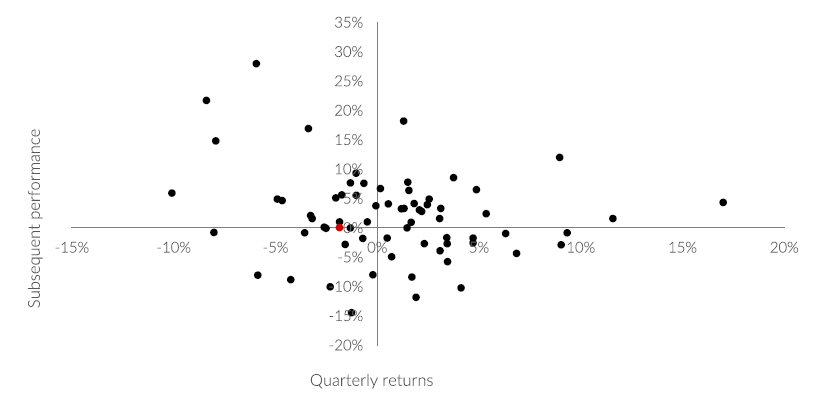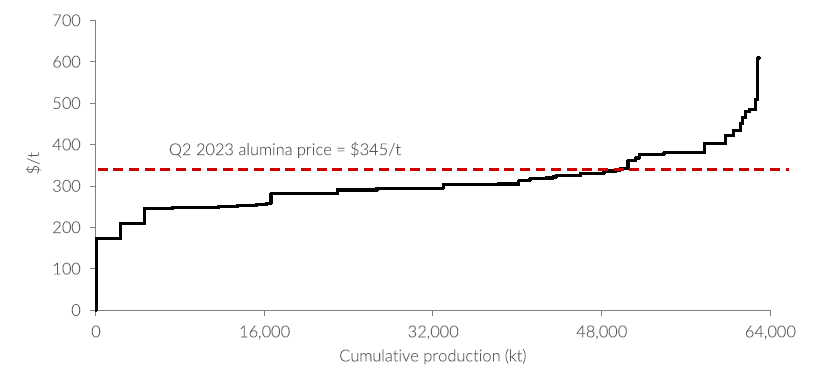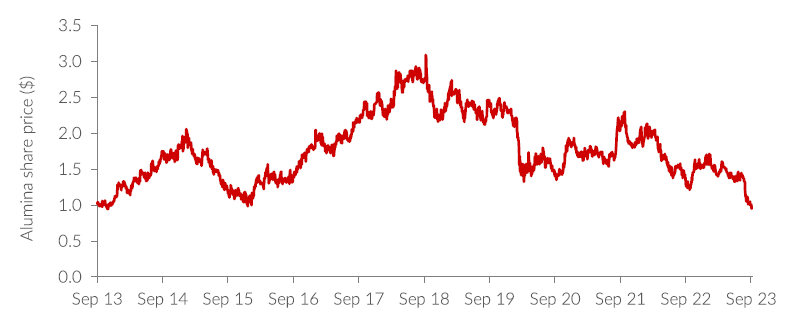Why we're still backing this ASX materials play, despite a soft quarter
As nice as great results every quarter would be, the nature of our contrarian, long-term strategy often means having to wait. Quarterly performance outcomes are impossible to predict and are uncorrelated with future returns, as we show below in this extract from our September 2023 Quarterly Commentary. Alumina Limited (ASX: AWC) was our Equity Fund’s biggest detractor over the period, so we explain our assessment of the reasons for Alumina’s underperformance, the effect on the company’s fundamental drivers of value and why we believe there could be rewards for the patient investor.
Commentary by Simon Mawhinney, Managing Director and Chief Investment Officer

This has been a weak quarter for the Allan Gray Australia Equity strategy, which, while disappointing, is not unusual.
Graph 1 plots our quarterly relative performance outcomes since inception (on the horizontal axis). The red dot shows the last quarter (as at 28 September 2023) — far from our worst quarter, but certainly on the wrong side of the spectrum. Quarterly performance outcomes are impossible to predict and are uncorrelated with future returns. The vertical axis shows subsequent performance over the following nine months, with the random scatter plot showing an absence of any strong correlation. It therefore stands to reason that investors should not obsess about our recent performance (let us worry about that!), as there will always be short-term volatility. Instead, we take a long-term view and focus on the fundamental drivers of value when we make investments in the strategy.
GRAPH 1 | Quarterly performance and subsequent performance relative to the S&P/ASX 300 Index

When it comes to these fundamental drivers there is cause for optimism. Earnings, a reasonable proxy for the cashflows investors can expect to earn from an investment, are the core input into a company’s value.
Table 1 shows that the Equity strategy trades at a significant discount to the broader sharemarket and its earnings are growing every bit as fast. This is usually a good backdrop for favourable future relative returns over the long term. Also interesting is the very significant discount to book value at which the strategy trades.
TABLE 1 | The Equity strategy trades at a significant discount to the sharemarket

Alumina Limited has been the biggest detractor during the quarter. The remainder of this quarterly commentary focuses on our assessment of the reasons for Alumina’s underperformance and the effect on Alumina’s fundamental drivers of value.
About Alumina Limited
We last wrote about Alumina Limited in our September 2020 quarterly commentary. Alumina Limited’s sole asset remains its 40% interest in the Alcoa World Alumina and Chemicals (AWAC) joint venture. Alcoa continues to own the other 60% and is the operator of the joint venture. In our September 2020 commentary, we described the then prevailing weak alumina markets, AWAC’s competitive position on the cost curve, its favourable environmental credentials, and the significant discount-to-replacement cost at which investors could buy the company.
Our thesis has not played out as we had hoped.
Three things in particular stand out:
- Energy cost spikes at San Ciprian: AWAC’s San Ciprian refinery in Spain was wrong-footed by its unhedged exposure to rapidly rising European gas prices. In response, AWAC reduced production to 50% of its nameplate capacity of 1.6 million tonnes per annum (mtpa). But the combination of higher gas prices and lower production to absorb fixed costs saw costs peak at US$664 per tonne (/t), well above the then-prevailing alumina price of US$344/t. Gas prices have moderated somewhat since then and cash costs have fallen to US$457/t. Despite the increased energy costs, alumina prices are broadly unchanged at US$340/t. San Ciprian continues to make losses of over US$100 million p.a. Prospects for a quick return to profitability are dim. The refinery is exposed to potential European winter gas price spikes and the labour laws in Spain make closing the facility difficult in the near term. While inconvenient this was manageable, given the offset from low-cost and profitable operations in Western Australia. But even that has recently changed.
-
Regulatory delays in Western Australia (WA): In WA, AWAC operates two bauxite mines (Huntly and Willowdale) and three refineries (Pinjarra, Wagerup, and Kwinana). WA State Agreements govern these operations and AWAC is required to submit annual rolling five-year mining management plans (MMPs) for approval. The review and approval of these plans involves expert input from a host of government departments (collectively known as the MMP Liaison Group, or MMPLG) with ultimate approval from the Minister of State Development in consultation with other ministers. This process has operated relatively seamlessly since the early-1960s. However, in February 2023, the WA Forest Alliance Group requested that the WA Environmental Protection Authority (EPA) conduct an environmental impact assessment on AWAC’s current MMP for the Huntly mine. At the heart of the concerns are two issues. Firstly, the degree with which AWAC has rehabilitated the Jarrah Forest that it requires to clear for its mining. Secondly, is AWAC’s mining proximity to the Serpentine Dam, which is critical to Perth’s drinking water supply. Despite AWAC having mined in the area for many decades, concerns exist that climate change and more extreme rainfall events present new risks to dam contamination from residue run-off from the Huntly mine.It is worth pointing out that AWAC only mines in areas where timber harvesting has historically occurred. It does not mine in gazetted national parks nor does it mine in old-growth forest areas. In 2022, 379 hectares of land were disturbed, and 509 hectares were rehabilitated (though in fairness, previous years were skewed the other way). Alcoa has committed to stepping up the pace of its rehabilitation.The EPA has yet to determine whether a formal environmental impact assessment is required, though this seems likely. This is not a concern for Alcoa, except that the process is likely to take some years and, in the interim, the MMPLG has imposed permit restrictions on AWAC’s current MMP. In turn these have forced AWAC to mine low-grade ore from Huntly, which primarily feeds the Kwinana refinery. The limited availability of bauxite ore and its low grade has resulted in reduced output from Kwinana and like at San Ciprian, the unit costs of production have risen sharply, and profits have fallen.
- Industry headwinds: In addition to the company specific issues mentioned above, industry-wide input costs (e.g. energy and, until recently, caustic soda, a key input) have increased considerably. This has not been offset by alumina price increases and swathes of world production (excluding China) are now loss making. The industry cost curve in Graph 2 shows cash-site costs, which we estimate to understate actual costs by US$25/t in sustaining capital and (at least) US$5/t in non-site costs.
GRAPH 2 | Industry cost curve

The impact of the above issues has caused AWAC’s cash costs to increase from the low $200s/t to well over $300/t today.
Adding salt to Alumina Limited’s wounds, is its requirement to fund its share of AWAC’s operating losses (predominantly from San Ciprian and Kwinana) or risk dilution of its 40% equity share in the joint venture. To do this, it has already accumulated US$221m of debt and has a facility limit of US$500m. If the uncertainties in San Ciprian and Western Australia weren’t enough to entice investors to push the sell button, the near-certain equity raising will almost definitely seal the deal.
GRAPH 3 | Alumina’s share price

It’s unwise to make decisions in a vacuum
None of the above news is good, but it is important to determine whether it is as bad as the share price indicates. We don’t have all the answers here, but there are several reasons why we believe the company might have been significantly oversold.
To us, it seems more likely than not that a workaround in WA is possible. This will enable AWAC to continue its mining operations until (and likely beyond) the EPA’s recommendations are made. If this were the case, profits in WA would improve significantly. They may even be sufficient to recoup losses at San Ciprian. Debt levels would cease to rise and may even fall.
But this could be a utopian view of the likely outcome and it isn’t wise to invest on the back of rosy assumptions.
It gets more interesting as we peel away more layers of the onion. If San Ciprian continues to make losses, it will certainly close at some stage. Or if the Huntly mine approvals are not renewed, the Kwinana refinery, which it supplies, will certainly close. This would remove a further one to two million tonnes of alumina production p.a. (in addition to the one mtpa from curtailments already made) and one only needs to look at fairly recent developments offshore to understand what the implications might be.
In early-2018, Norsk Hydro’s Alunorte refinery in Brazil was forced to run at 50% of its 6mtpa capacity due to environmental concerns surrounding potential spills or overflows from its bauxite residue areas. The impact on alumina supply was similar to a combined San Ciprian and Kwinana closure. By mid-April that year, alumina prices had rallied to US$710/t due to concerns about alumina supply.
This is not to say that today’s impact would be the same. It might have a lower impact, or it might have a greater impact, given the much higher industry costs today.
Rather, our point is that it’s unwise to make investment decisions in a vacuum. There are always second-order impacts of assumption changes, and, in Alumina’s case, these might significantly increase the intrinsic value of its remaining production.
Alumina Limited has an enterprise value of US$2.2 billion and has guided to produce its 40% share of 10.3mt of alumina in 2023. We believe there are reasonable prospects for Alumina Limited to make US$400m in pre-tax earnings. The company trades for US$550/t of annual production (and even lower if you adjust for shut-in capacity), less than half the cost of newer higher-cost capacity in developing markets. Even if Kwinana and San Ciprian were both closed and closure costs amounted to US$500m, Alumina Limited would still trade at a significant discount to the cheapest replacement capacity available.
The path forward is unclear and while the intrinsic value of our investment has fallen (by at least the increase of US$220m of net debt) the share price has fallen far more. It is not unusual for the sharemarket to overreact to uncertainty this great and to also ignore potentially favourable second-order impacts.
As nice as great results every quarter would be, the nature of our contrarian, long-term strategy often means having to wait, sometimes for several years, for our investment theses to play out. And the future often turns out very different to what we have predicted or hoped for. We can’t say for certain what will happen to Alumina, but we do know that it’s easy for investors to be constrained by short-term thinking and to anchor their thinking in the present. If we can find an above-average company, at a weak point in its cycle when sentiment is low, we can increase your chances of upside. We believe sentiment for Alumina is currently at an all-time low.
The above wire is an extract from Allan Gray Australia’s September 2023 Quarterly Commentary, which you can read in full here.
4 topics
1 stock mentioned

